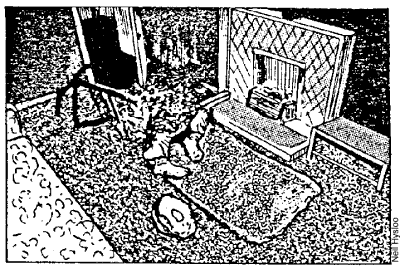 |
Science Frontiers ONLINE No. 46: Jul-Aug 1986 |
|
|
Spontaneous Human Combustion
John Heymer's job with the Gwent Police was attending the scenes of serious crimes and sudden deaths to gather forensic evidence. On January 6, 1980, he investigated a "rather unusual" death at a Gwent council house.
When he opened the door of the room, steamy, sauna-like heat still remained. The walls still radiated heat; condensation was running down the window; all surfaces were covered with a greasy black soot.
"On the floor, about one metre from the hearth, was a pile of ashes. On the perimeter of the ashes, furthest from the hearth, was a partially burnt armchair. Emerging from the ashes were a pair of human feet clothed in socks. The feet were attached to short lengths of lower leg, encased in trouser leg bottoms. The feet and socks were undamaged. Protruding from what was left of the trousers were calcined leg bones which merged into the ashes. The ashes were the incinerated remains of a man."Of the torso and arms nothing remained but ash. Opposite the feet was a blackened skull. Though the rug and carpet below the ashes were charred, the damage did not extend more than a few centimetres beyond the perimeter of the ashes. Less than a metre away, a settee, fitted with loose covers, was not even scorched. Plastic tiles which covered the floor beneath the carpet were undamaged."
We do not have space for additional details and must conclude with two questions posed by Heymer: (1) Human combustion requires a temperature of 1600�C (assuming no draft) applied for many hours; how was such heat achieved in a closed room without scorching nearby materials? (2) In the hottest of fires, the extremities are consumed but the torso remains; why did the reverse happen here and in other reported cases of human combustion?
(Heymer, John; "A Case of Spontaneous Human Combustion? New Scientist, p. 70, May 15, 1986.)
But every tale has two (or more) sides. The following letter appeared in response to the above article:
"John Heymer will no doubt assume that I am suffering from the 'Lavoisier Syndrome' if I disagree with the conclusion he had reached from his meticulous observations. His mistake is in trying to draw a parallel between the extensive burning to the body which he examined and the processes of cremation, when they can be distinguished by one critical factor. Cremation is intended to destroy a body in the shortest possible time and is therefore carried out under extreme conditions, but a relatively small fire can consume flesh and calcine bone if it is allowed to burn for a long time."This process, which I prefer to call prolonged human combustion, is usually fuelled by fat rendered from the body by the fire. It is no coincidence that in many of the cases this unit has encountered the victim was obese, and there was always a long delay before the fire was discovered. Examples of prolonged human combustion are, admittedly, rare but this should not be taken as evidence that an unusual source of ignition is involved. Indeed, all cases investigated by this unit have been resolved to the satisfaction of the courts without recourse to the excuse of 'spontaneous' human combustion."
(Halliday, D.J.X.: "Human Combustion," p. 63, May 29, 1986.)
Comment. Halliday works for the Fire Investigation Unit of the London police.
Reference. Spontaneous human combustion is covered in more detail in BHC7 in Biological Anomalies: Humans II. To order, see: here.
 | Remains of 'combusted' human. (adapted from New Scientist) |